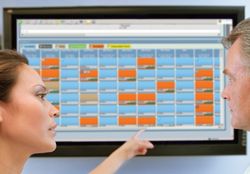South Carolina hospital network Trident Heath System, a member of HCA Healthcare, is using real-time location system (RTLS) software provided by GE Healthcare and RFID hardware from RF Code to track assets in two of its three Charleston-area facilities and manage beds in all three of its facilities. The recent bed-management system is intended to increase throughput of patients and prevent delays created by a lack of information about bed availability. In the meantime, each nurse is saving, on average, 15 minutes per shift that was previously spent looking for equipment.
Trident Healthcare consists of three facilities: Summerville Medical Center with 94 beds, Trident Medical Center with 296 beds, and Moncks Corner Medical Center, an outpatient diagnostic center with a 24-hour emergency room. The three facilities manage a combined total of 94,000 visits annually, according to Sherry Washington, RN, director of support services and patient flow, Trident Health Systems who described the RTLS project during a presentation at the RFID Journal LIVE! 2010 conference, held last week in Orlando, Fla.
Initially, in 2007, the hospital began looking for a system to track its equipment, which was often hard to find and sometimes underutilized simply because it was hard to locate. “Our goal was to have clean, available equipment,” says Washington. The hospital’s focus was learning to understand the problem and then create an accurate solution that would be scalable and flexible. It found that the equipment was at a 40 percent utilization rate overall, with what nurses perceived as IV pump availability at 36 percent, and nurses were spending about 21 minutes per shift looking for needed equipment. The hospital also hoped to reduce the lease and rental fees of replacement equipment, as well as the cost of replacing lost items.
In 2008 Trident installed GE’s AgileTrac Asset Manager Internet-based software system as well as RFID readers and tags and infrared emitters from RF Code, and began tagging 3,000 pieces of equipment including telemetry boxes, IV pumps, wheelchairs and patient-controlled analgesia (PCA) pumps. The company installed RFID readers throughout the two buildings and placed an IR emitter on the ceiling at the center of each room. Each RF Code RFID tags has a built-in IR sensor that receives an emitter’s IR signal and then transmits a 433 MHz signal encoded with its own unique ID number along with that of the IR emitter. The readers receive the tag’s 433 MHz signal and then forwards the tag data via a cabled connection to the AgileTrac software residing on Trident Health System’s back-end server. AgileTrac identifies the location of the tag based on the IR emitter ID and presents the tag’s location on a display of the hospital.
AgileTrac software allows the hospitals to find a piece of equipment within the facility by inputting the item being searched for, or by looking at a display of a room, zone or floor, on any desktop computer. By using the system the hospital is able to calculate such things as the utilization rate of existing equipment, the time spent finding items, the distribution of biomedical devices and the process for rental and lease management, says Washington.
Seeing the advantages to the asset-tracking system, ten months ago the hospital began working with GE to develop a bed-management system to improve patient flow at all three facilities. “Lack of inpatient beds is the main factor that contributes to emergency-department crowding,” says Washington. At intensive care units (ICUs), the discharge of patients peaks on Monday and Tuesday, and 65 percent of patient discharges take place between 2 pm and 5 pm, leading to backups at peak times and days. Often patients were delayed in ICU as they awaited regular hospital beds. The goal in this case was what Washington calls “the all-hands-on-deck approach.” That is, she wanted a system in which all hospital staff could access the data, and could also be held accountable for patient flow, ensuring that beds are made available at a timely rate and that information is then provided to those who need it.

Cleaning staff carry a handheld RF Code RFID/IR tag equipped with two buttons. When workers press the first button, it indicates they have entered a room and have begun cleaning. When they press the second button, the system is alerted that the room is cleaned and ready for the next patient. In both cases, the data including the tag’s unique ID number of the device’s tag and the IR identifier of the room is transmitted with the button pressed data to the closest RFID antenna. AgileTrac software receives those cues and then sends an alert to the appropriate department, such as admissions when a room is cleaned and available, to alert staff that they can now proceed with the next stage of patient flow.
The software also presents color-coded icons to those who do a search of a room in the software. A green icon, for example, could indicate a room is in the process of being cleaned. Once in place, the system enabled the hospital to reduce delays, and have faster room turnover. The three facilities’ registration departments have reported that they have reduced the time needed to register a patient by an average of 15 minutes, Washington says. Staff use the system to identify the bed’s status as well as request beds, process bed requests, manage housekeeping activity and manage the discharge processes, Washington says.
To date, Trident Heath System has installed a total of 73 RFID readers and 660 IR emitters at its three sites. On Apr. 26, Trident intends to begin tracking some patients. This would allow staff and physicians to know where a patient is, and also further automate the bed-management process. In this case the hospital plans to install “smart boxes,” which would be containers for patient RFID tags and would come with built-in RFID readers. When a patient was discharged, staff would remove the wristband tag and place it in the smart box, which would read the tag’s ID number and send that data back to the admissions system to indicate that a patient has been discharged and therefore the room has been vacated.
In addition to patient monitoring, Washington says she is now interested in expanding into OR workflow management, although she did not indicate when that would take place.
Since the asset system was in place, the average 21 minutes to seek equipment has been reduced to five minutes per nurse, per shift. Trident is working with GE to further the use of the RTLS infrastructure for more efficiency gains and equipment utilization.


